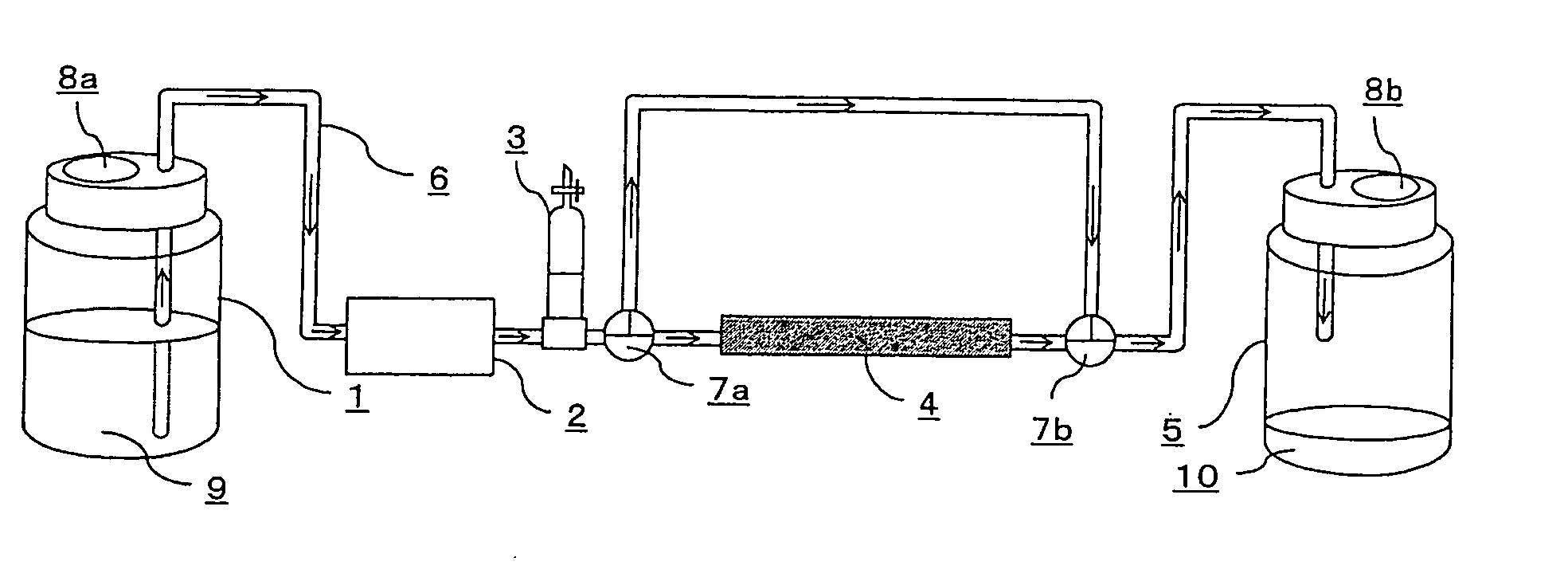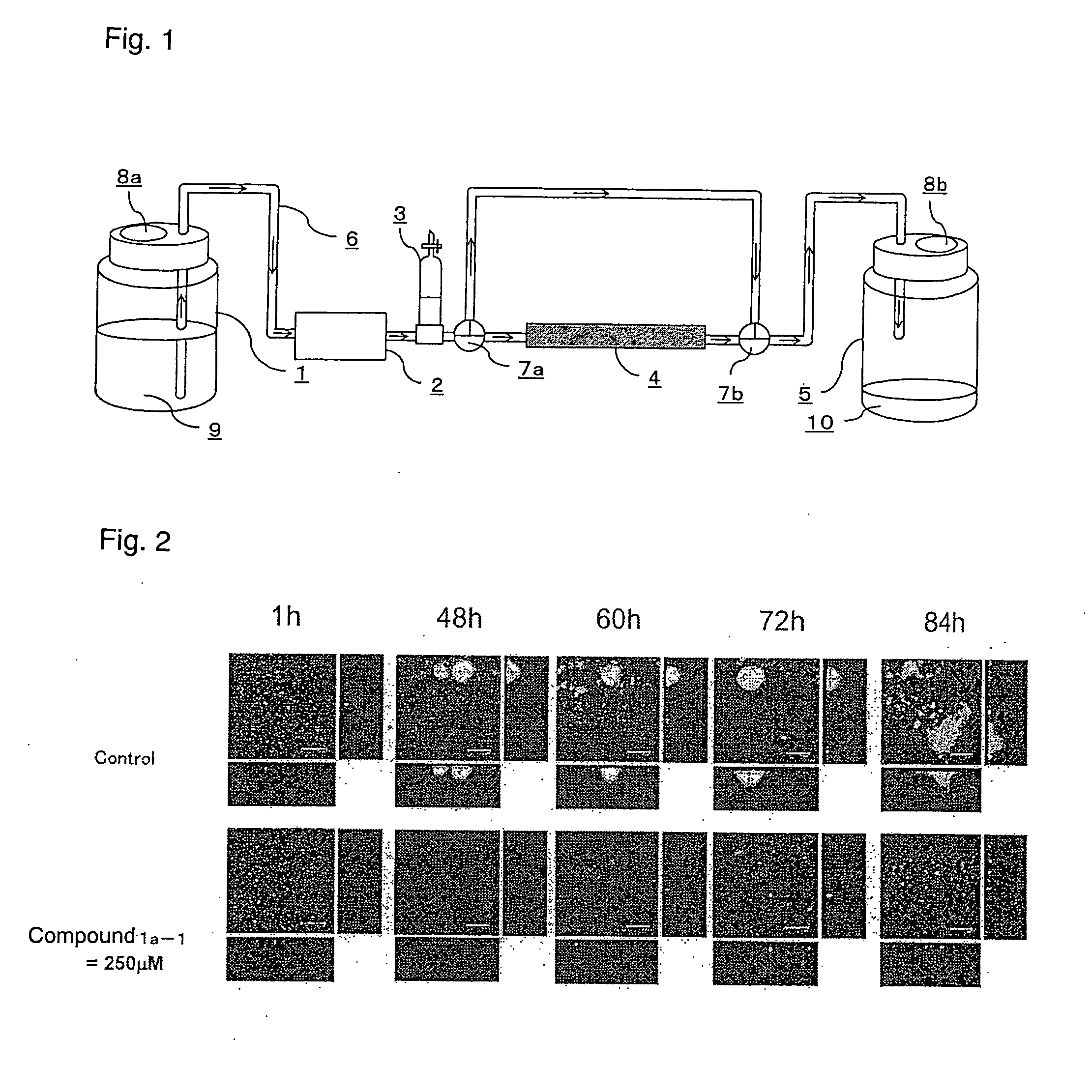Amide compound or salt thereof, and biofilm inhibitor, biofilm remover and disinfectant containing the same
a technology of biofilms and compounds, applied in the direction of heterocyclic compound active ingredients, biocide, disinfectants, etc., can solve the problems of destroying the film, and document 1 and 2 cannot be stripped or removed. , to achieve the effect of reducing the thickness of the formed or deposited biofilms
- Summary
- Abstract
- Description
- Claims
- Application Information
AI Technical Summary
Benefits of technology
Problems solved by technology
Method used
Image
Examples
production example 1
Production of N-(pyrrolidin-3-yl) dodecanoyl amide (1a-1)
[0101]0.22 g (1 mmol) of dodecanoyl chloride and 0.18 g (2.1 mmol) of 3-aminopyrrolidine are dissolved in 10 ml of dichloromethane. The solution was stirred while cooled with ice for 12 hours. The reaction liquid was concentrated under reduced pressure. The resultant residue was subjected to extraction with ethyl acetate. The obtained ethyl acetate layer was washed with diluted hydrochloric acid and saturated saline, dried with magnesium sulfate, and concentrated under reduced pressure. The resulting residue was purified by silica gel chromatography (developing solvent: hexane / ethyl acetate=3 / 7) to obtain a N-(pyrrolidin-3-yl) dodecanoyl amide (Compound 1a-1) denoted by the following formula.
[0102]Quantity Yield: 0.18 g (0.69 mmol)
[0103]Percent Yield: 69%
[0104]1H-NMR (CDCl3, 500 MHz): 0.90 ppm (t, 3H), 1.28 ppm (m, 16H), 1.64 ppm (t, 2H), 1.76 ppm (m, 1H), 2.00 ppm (br, 1H), 2.13 ppm (m, 1H), 2.27 ppm (t, 2H), 3.24 ppm (m, 1H)...
production example 2
Production of N-(pyrrolidin-3-yl) decanoyl amide (Compound 1a-2)
[0105]The same process as that of Production Example 1 was conducted except that decanoyl chloride was used in place of dodecanoyl chloride to obtain N-(pyrrolidin-3-yl) decanoyl amide (Compound 1a-2) denoted by the following formula.
[0106]Quantity Yield: 0.15 g (0.62 mmol)
[0107]Percent Yield: 62%
[0108]1H-NMR (CDCl3, 500 MHz): 0.88 ppm (t, 3H), 1.29 ppm (m, 12H), 1.65 ppm (m, 2H), 1.88 ppm (m, 1H), 2.10 ppm (m, 1H), 2.26 ppm (m, 2H), 3.21 ppm (m, 1H), 3.49 ppm (m, 1H), 3.65 ppm (m, 3H), 8.59 ppm (br, 1H).
production example 3
Production of N-(piperidine-4-yl) dodecanoyl amide (1b-1)
[0109]The same process as that of Production Example 1 was conducted except that 4-aminopiperidine was used in place of 3-aminopyrrolidine to obtain N-(piperidine-4-yl) dodecanoyl amide (1b-1) denoted by the following formula.
[0110]Quantity Yield: 0.16 g (0.56 mmol)
[0111]Percent Yield: 56%
[0112]1H-NMR (CDCl3, 500 MHz): 0.88 ppm (t, 3H), 1.27 ppm (m, 18H), 1.59 ppm (m, 2H), 1.86 ppm (m, 2H), 2.30 ppm (t, 2H), 2.68 ppm (t, 1H), 2.89 ppm (m, 1H), 3.05 ppm (t, 1H), 3.71 ppm (d, 1H), 4.51 ppm (d, 1H).
PUM
| Property | Measurement | Unit |
|---|---|---|
| Mass | aaaaa | aaaaa |
| Density | aaaaa | aaaaa |
| Density | aaaaa | aaaaa |
Abstract
Description
Claims
Application Information
 Login to View More
Login to View More - R&D
- Intellectual Property
- Life Sciences
- Materials
- Tech Scout
- Unparalleled Data Quality
- Higher Quality Content
- 60% Fewer Hallucinations
Browse by: Latest US Patents, China's latest patents, Technical Efficacy Thesaurus, Application Domain, Technology Topic, Popular Technical Reports.
© 2025 PatSnap. All rights reserved.Legal|Privacy policy|Modern Slavery Act Transparency Statement|Sitemap|About US| Contact US: help@patsnap.com



